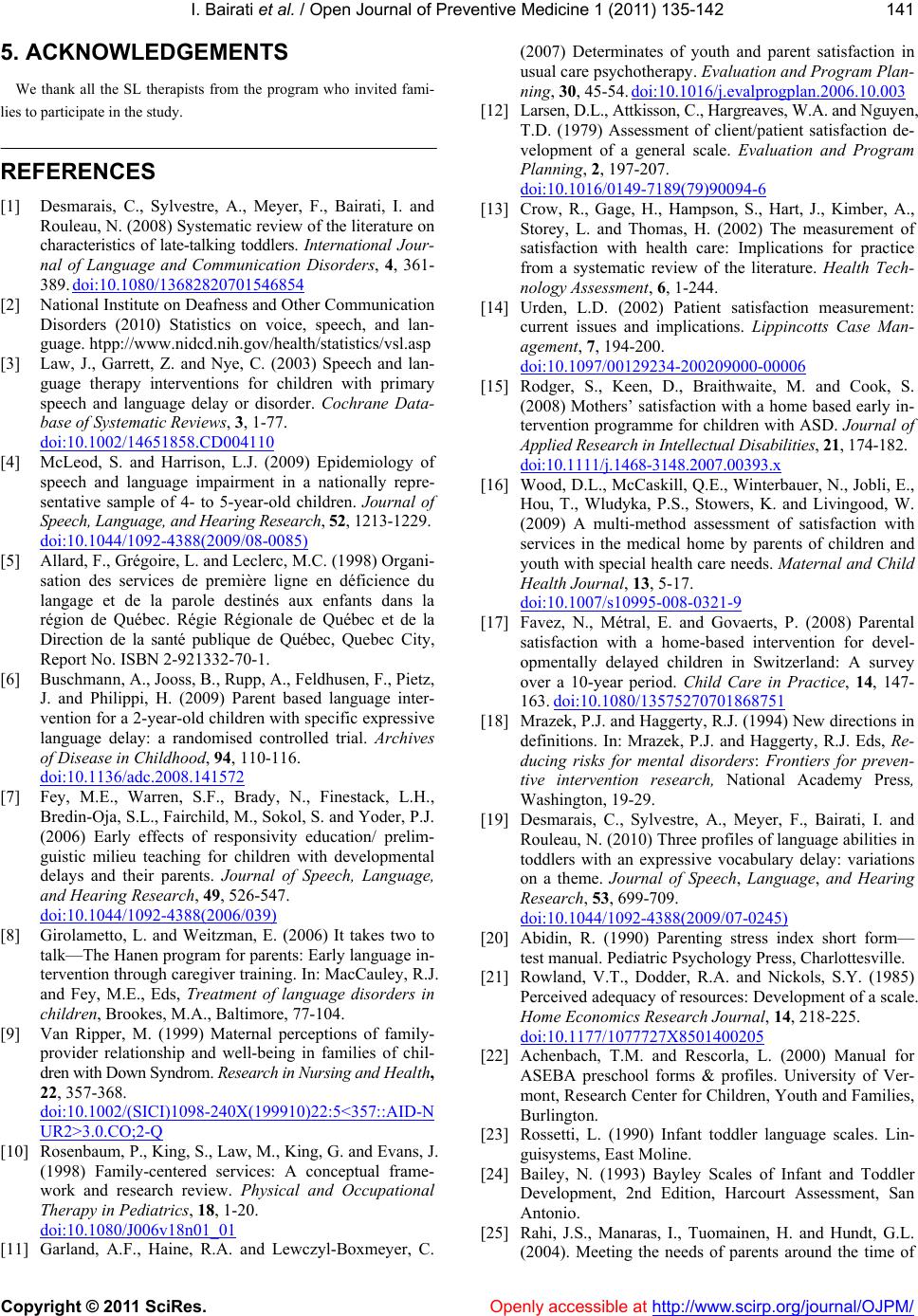
I. Bairati et al. / Open Journal of Preventive Medicine 1 (2 011) 135-142
Copyright © 2011 SciRes. Openly accessible at http://www.scirp.org/journal/OJPM/
141
5. ACKNOWLEDGEMENTS
We thank all the SL therapists from the program who invited fami-
lies to participate in the study.
REFERENCES
[1] Desmarais, C., Sylvestre, A., Meyer, F., Bairati, I. and
Rouleau, N. (2008) Systematic review of the literature on
characteristics of late-talking toddlers. International Jour-
nal of Language and Communication Disorders, 4, 361-
389. doi:10.1080/13682820701546854
[2] National Institute on Deafness and Other Communication
Disorders (2010) Statistics on voice, speech, and lan-
guage. htpp://www.nidcd.nih.gov/health/statistics/vsl.asp
[3] Law, J., Garrett, Z. and Nye, C. (2003) Speech and lan-
guage therapy interventions for children with primary
speech and language delay or disorder. Cochrane Data-
base of Systematic Reviews, 3, 1-77.
doi:10.1002/14651858.CD004110
[4] McLeod, S. and Harrison, L.J. (2009) Epidemiology of
speech and language impairment in a nationally repre-
sentative sample of 4- to 5-year-old children. Journal of
Speech, Language, and Hearing Research, 52, 1213-1229.
doi:10.1044/1092-4388(2009/08-0085)
[5] Allard, F., Grégoire, L. and Leclerc, M.C. (1998) Organi-
sation des services de première ligne en déficience du
langage et de la parole destinés aux enfants dans la
région de Québec. Régie Régionale de Québec et de la
Direction de la santé publique de Québec, Quebec City,
Report No. ISBN 2-921332-70-1.
[6] Buschmann, A., Jooss, B., Rupp, A., Feldhusen, F., Pietz,
J. and Philippi, H. (2009) Parent based language inter-
vention for a 2-year-old children with specific expressive
language delay: a randomised controlled trial. Archives
of Disease in Childhood, 94, 110-116.
doi:10.1136/adc.2008.141572
[7] Fey, M.E., Warren, S.F., Brady, N., Finestack, L.H.,
Bredin-Oja, S.L., Fairchild, M., Sokol, S. and Yoder, P.J.
(2006) Early effects of responsivity education/ prelim-
guistic milieu teaching for children with developmental
delays and their parents. Journal of Speech, Language,
and Hearing Research, 49, 526-547.
doi:10.1044/1092-4388(2006/039)
[8] Girolametto, L. and Weitzman, E. (2006) It takes two to
talk—The Hanen program for parents: Early language in-
tervention through caregiver training. In: MacCauley, R.J.
and Fey, M.E., Eds, Treatment of language disorders in
children, Brookes, M.A., Baltimore, 77-104.
[9] Van Ripper, M. (1999) Maternal perceptions of family-
provider relationship and well-being in families of chil-
dren with Down Syndrom. Resear ch in Nurs ing an d Health,
22, 357-368.
doi:10.1002/(SICI)1098-240X(199910)22:5<357::AID-N
UR2>3.0.CO;2-Q
[10] Rosenbaum, P., King, S., Law, M., King, G. and Evans, J.
(1998) Family-centered services: A conceptual frame-
work and research review. Physical and Occupational
Therapy in Pediatrics, 18, 1-20.
doi:10.1080/J006v18n01_01
[11] Garland, A.F., Haine, R.A. and Lewczyl-Boxmeyer, C.
(2007) Determinates of youth and parent satisfaction in
usual care psychotherapy. Evaluation and Program Plan-
ning, 30, 45-54. doi:10.1016/j.evalprogplan.2006.10.003
[12] Larsen, D.L., Attkisson, C., Hargreaves, W.A. and Nguyen,
T.D. (1979) Assessment of client/patient satisfaction de-
velopment of a general scale. Evaluation and Program
Planning, 2, 197-207.
doi:10.1016/0149-7189(79)90094-6
[13] Crow, R., Gage, H., Hampson, S., Hart, J., Kimber, A.,
Storey, L. and Thomas, H. (2002) The measurement of
satisfaction with health care: Implications for practice
from a systematic review of the literature. Health Tech-
nology Assessment, 6, 1-244.
[14] Urden, L.D. (2002) Patient satisfaction measurement:
current issues and implications. Lippincotts Case Man-
agement, 7, 194-200.
doi:10.1097/00129234-200209000-00006
[15] Rodger, S., Keen, D., Braithwaite, M. and Cook, S.
(2008) Mothers’ satisfaction with a home based early in-
tervention programme for children with ASD. Journal of
Applied Research in Intellectual Disabilities, 21, 174-182.
doi:10.1111/j.1468-3148.2 007.00 393.x
[16] Wood, D.L., McCaskill, Q.E., Winterbauer, N., Jobli, E.,
Hou, T., Wludyka, P.S., Stowers, K. and Livingood, W.
(2009) A multi-method assessment of satisfaction with
services in the medical home by parents of children and
youth with special health care needs. Maternal and Child
Health Journal, 13, 5-17.
doi:10.1007/s10995-008-0321-9
[17] Favez, N., Métral, E. and Govaerts, P. (2008) Parental
satisfaction with a home-based intervention for devel-
opmentally delayed children in Switzerland: A survey
over a 10-year period. Child Care in Practice, 14, 147-
163. doi:10.1080/13575270701868751
[18] Mrazek, P.J. and Haggerty, R.J. (1994) New directions in
definitions. In: Mrazek, P.J. and Haggerty, R.J. Eds, Re-
ducing risks for mental disorders: Frontiers for preven-
tive intervention research, National Academy Press,
Washington, 19-29.
[19] Desmarais, C., Sylvestre, A., Meyer, F., Bairati, I. and
Rouleau, N. (2010) Three profiles of language abilities in
toddlers with an expressive vocabulary delay: variations
on a theme. Journal of Speech, Language, and Hearing
Research, 53, 699-709.
doi:10.1044/1092-4388(2009/07-0245)
[20] Abidin, R. (1990) Parenting stress index short form—
test manual. Pediatric Psychology Press, Charlottesville.
[21] Rowland, V.T., Dodder, R.A. and Nickols, S.Y. (1985)
Perceived adequacy of resources: Development of a scale.
Home Economics Research Journal, 14, 218-225.
doi:10.1177/1077727X8501400205
[22] Achenbach, T.M. and Rescorla, L. (2000) Manual for
ASEBA preschool forms & profiles. University of Ver-
mont, Research Center for Children, Youth and Families,
Burlington.
[23] Rossetti, L. (1990) Infant toddler language scales. Lin-
guisystems, East Moline.
[24] Bailey, N. (1993) Bayley Scales of Infant and Toddler
Development, 2nd Edition, Harcourt Assessment, San
Antonio.
[25] Rahi, J.S., Manaras, I., Tuomainen, H. and Hundt, G.L.
(2004). Meeting the needs of parents around the time of